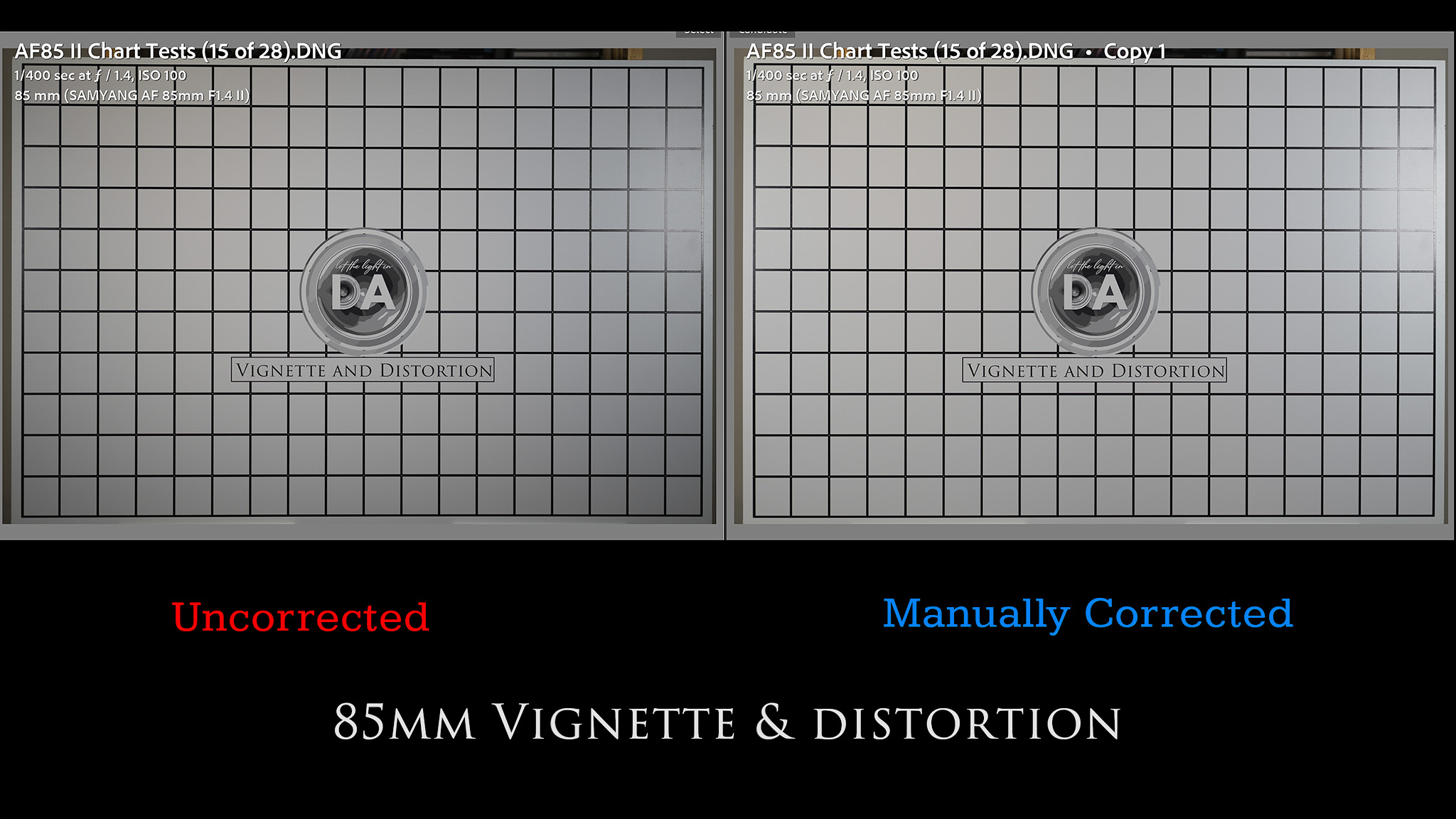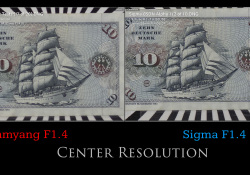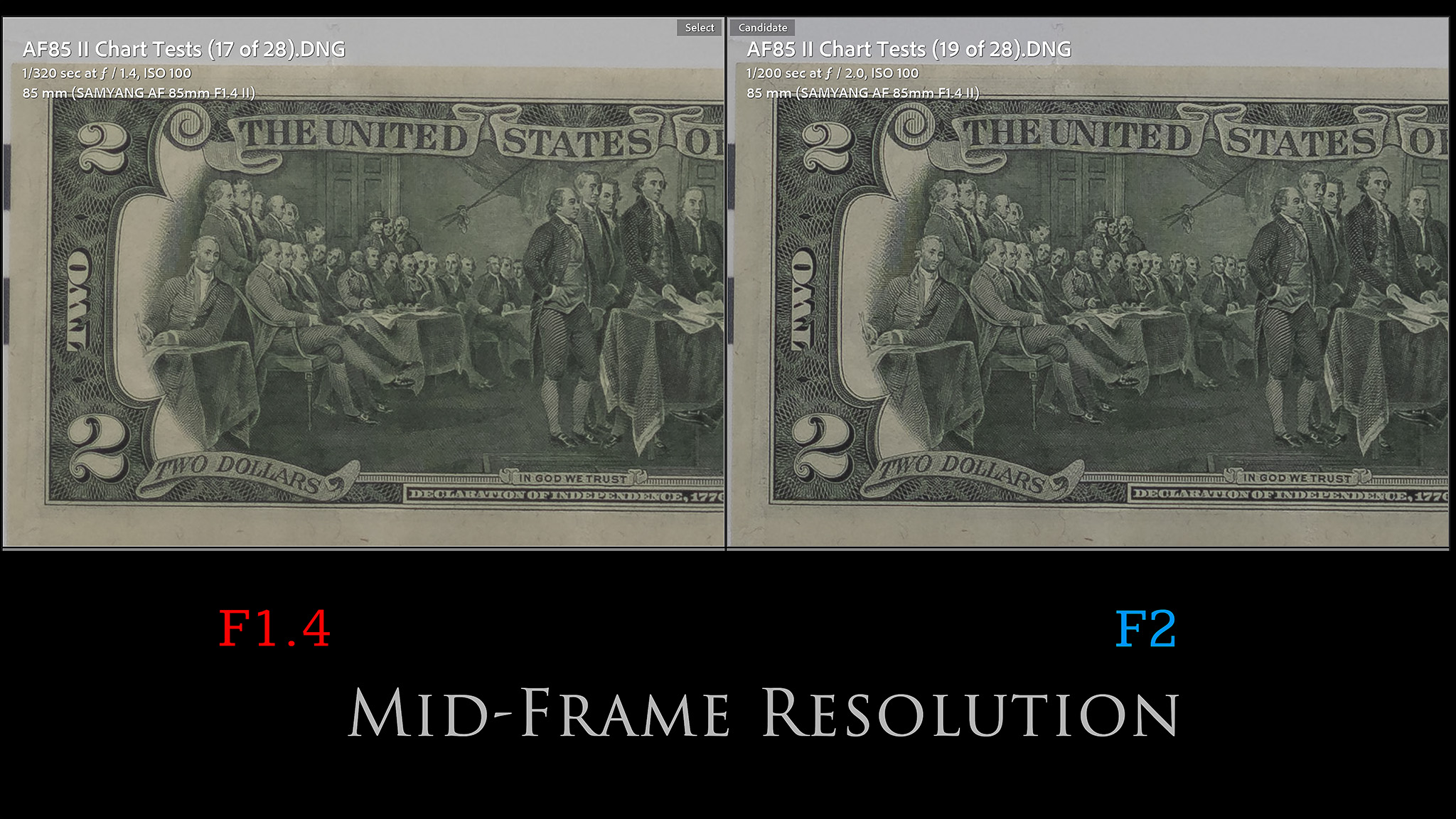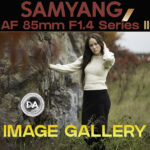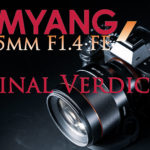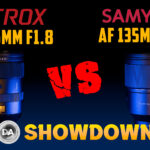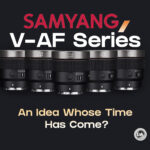My excitement over reviewing a new Samyang lens has grown by leaps and bounds over the past three years. In my DSLR days I had treated Samyang much like some of the budget manual focus lens players on the market today (7Artisans, TTArtisan, Brightin Star, etc…). They produced lenses that were sometimes optically interesting but not really at the same level as the big players in terms of build, features, and autofocus. They even sold their lenses under multiple brand names, of which only Samyang and Rokinon remain (yes, Rokinon lenses are the exact same save slightly different badging). But then Samyang started to experiment with autofocus, and, while early results were a little primitive, I saw rapid progress. About 3 ½ years ago I reviewed the first Samyang lens that I thought was truly competitive with the main brands, and it was the Samyang AF 85mm F1.4 FE. I subsequently reviewed the Canon RF mount version of the lens and found it even better (they added an AF/MF switch to the design). I added that lens to my own personal Canon kit and still regularly use it today. Today, however, I’m looking at the second generation of Samyang’s “big” prime lenses. I first looked at the Series II version of the AF 50mm F1.4, and found it a major improvement over the first generation lens. Today I’ll be examining the new Samyang AF 85mm F1.4 Series II, hereby referred to as the AF 85II. I will subsequently be looking at the new 35mm F1.4 Series II along with the impressive Samyang AF 135mm F1.8.
I’m excited about this Samyang lens as I’ve always appreciated the performance and value of the previous versions of the lens, and now we’ve gotten a more compact size along with new features as a part of the formula. The new version is slimmer and lighter along with some other significant improvements:
- Smaller size:
- MK 1 88 x 99.5 (D x L) | 568g weight | 77mm filter thread
- MK 2 83.4 x 99.5 (D x L) | 509g weight | 72mm filter thread
- Slightly improved MFD (0.85 vs 0.90 = 0.12 vs 0.11x)
- AF Motor improved to Linear STM (Samyang claims improved performance for video. “Quieter, faster, and more accurate AF performance”
- Improved weather sealing – from 3 seal points to 7 seal points
- Added Focus Hold Button and Custom Switch
We’ll detail those features further, but clearly Samyang is upping its game in terms of providing lenses that are competitive with third party brands and even with first party options. For now, the AF 85II is only available on Sony FE, though here’s hoping that Canon and Nikon will wake up and allow their customers access to these excellent new lenses. The AF 85II comes at a price point of right under $800 USD, which places it only $200 more than the Sony F1.8 version (my review here) and about $400 cheaper than the lens I consider to be the chief competitor to this lens – the Sigma 85mm F1.4 DN ART (my review here).
So is the new Samyang AF 85mm F1.4 Series II worthy of your consideration if you’re in the market for a new lens? Is it worth the upgrade if you own the previous generation lens? I’ll do my best to answer those questions either in my video review or in the text review that follows.
Follow Me @ YouTube | Patreon | Instagram | Facebook | DA Merchandise | Flickr | 500px
I want to thank Samyang for sending me a test retail copy of the lens for review. As always, this is a completely independent review. The opinions here are completely my own. *The tests and most of the photos that I share as a part of my review cycle have been done with the new Sony Alpha 1 which will serve as my benchmark camera for the foreseeable future (my review here) and the Sony a7IV
Samyang AF 85II Build, Design and Handling
The AF 85II is a reflection of Samyang’s growing design evolution. It very strongly resembles the AF 50mm F1.4 Series II lens with what has become Samyang’s new design language. This includes a new diamond pattern texture of the focus ring and a transition of Samyang’s red ring (which previously really imitated Canon’s L-series lenses) to the new “hidden ring” design where the red is only visible from the front of the lens as it is somewhat hidden in the front fascia of the lens barrel. The resulting lens design is clean and modern.
I liked the look of the previous Samyang AF 85mm F1.4 and its sleek design, but the new design language is, I think, more distinctly Samyang’s rather than a simile of someone else’s lens. A byproduct of this process has been the ability to also slightly reduce the physical size of the Series II lenses, which is in keeping with the trend that Sony has been following with its MK II G Master designs. Of the competing options, the new AF 85II is the overall smallest and lightest, though not in every dimension.
It has shed about 60g (2oz) relative to the Series I lens, and weighs in at about 115g lighter than the Sigma DN lens and a whopping 310g lighter than the Sony G Master. It is only 140g heavier than the Sony 85mm F1.8 lens, which makes it competitive in the F1.8 market in both size and price. Here’s a look at the two Series II lenses I have on hand and then the RF version of the first generation AF 85mm F1.4, which definitely looks bigger all around.
The Sigma DN lens isn’t really larger in pure physical size, but I do prefer the profile of the Samyang once the lens hoods are attached. The Sigma hood is relatively huge in diameter, which takes up much more room in a bag.
I’ve watched Samyang grow in their lens design over the past 3-4 years as they steadily debuted new features. One of those was weather sealing, which the first generation lens had, though with fewer seal points (only three on that lens). I count seven seal points from this diagram on the Series II lens, including at various transition points in the lens (front and rear element, either side of the focus ring, and at the switches).
I consider weather sealing to be a must if you want to market your lens as a premium or professional lens, and Samyang has smartly recognized that many photographers feel the same. They’ve definitely embraced weather sealing as a part of lens design, which does help inspire confidence when the weather turns during a photo shoot…like it did during this one, with a burst of cold rain.
The Series II lenses features some newer features for Samyang which have debuted over the past two years. One is a custom switch that gives you some options for how the focus ring will be used. You can tweak the options via the Samyang Lens Station (a $60 purchase I definitely recommend as it also allows you to quickly update the firmware. This might help with some improvement to performance and also will keep your investment “future-proofed”). I would like to see Samyang move to a lens-based USB-C port like Tamron and Viltrox have moved to, as that eliminates the need for an additional accessory for this functionality.
My preferred setup is that the M1 position has the ring focus as an aperture ring and the M2 position automatically enables manual focus. This gives you the functionality of an aperture ring and an AF/MF switch in one.
There’s also now a focus hold button which can be programmed to a variety of functions from within the camera just like on a Sony lens.
The manual focus ring is nice and wide and has that new textured surface (with a rubberized finish). I like the tactile feel of the “micro pattern” (as Samyang calls it) and feel like it offers good grip. The damping of the focus ring is nice and smooth, though I felt like I could use just a little more precision in the ring when making very fine adjustments. The focus action appears to be linear (non-speed dependent), which is good for repeatability, though the focus throw is too long for major video focus throws. You need about 5 normal focus rotations to travel the extremes of the focus range, and I estimate the whole focus throw at somewhere near 380°. Fortunately you can control the speed of the focus ring via the Lens Manager software if you have the Lens Station. On a positive note, the automatic magnification of the active focus area is engaged with the lens, which helps make the manual focus process more intuitive and accurate.
The lens hood is included. It’s plastic and pretty basic. It bayonets into place smoothly and locks tightly but lacks a dedicated locking mechanism (if that matters to you).
The body materials here are engineered plastics, but good feeling plastics, and the build feels solid if not exceptional. The lens feels quality but not necessarily top tier in build…which frankly is where the price point is.
Up front we have a clean front fascia and a 72mm filter thread size that is shared with the new 50mm F1.4 II.
If you look inside, you’ll find an aperture iris with 9 rounded blades, though the shape of the aperture blades will start to show up by F2.8 in a mild way. Here’s a look at the shape of the bokeh circles at F1.4, F2, and F2.8.
The geometric shape is pretty nice, and the bokeh circles are nice and soft. Fringing around the bokeh highlights is not at all pronounced, so you won’t have to fear shooting portraits or other shots with bright lights in the background.
As noted in the intro, Samyang has managed to very slightly improve the minimum focus distance over the first-generation lens from 90cm (2.95’) to 85cm (2.8’), which increases the magnification from 0.11x to 0.12x. That’s about average for an 85mm lens. Here’s what the magnification looks like:
The large maximum aperture and longer focal length allow the AF 85II to nicely isolate subjects and leave backgrounds completely defocused. The fact that the lens is also very sharp produces great looking images with sharp detail on the subject and beautifully blurred backgrounds.
There’s something very pleasing about this Series II lens. It strikes a very nice balance between a quality build while also being compact and lightweight. I like the general profile and look of the lens and appreciate the growing functionality that Samyang is building into these new lenses. They don’t have quite the level of robustness that either a Sony GM or the recent Sigma DN prime lenses do, but this is compensated for by reduced size and weight. I’m happy with the general trend of Samyang design.
Autofocus Performance
The Samyang AF 85mm F1.4 II employs a Linear STM focus motor. On paper this is a step down from the first-generation lens, as it employed a DLSM (Dual Linear Sonic Motor) focus system. One motor certainly wouldn’t seem to match two motors, yet Samyang claims “Quieter, faster and more accurate AF performance with linear STM motor”. I didn’t have the original first generation lens in Sony FE (I have one in Canon RF mount) on hand to compare the new lens with, but I did refer back to my review notes and images taken with that lens for some comparisons. I noted in my review of that lens that this was the area I felt still needed the most improvement. AF-C focus speed was somewhat slowed relative to AF-S, and I felt the focus system could use a little more torque. I also found that (at least initially), the older lens wasn’t always completely confident in focus and would have some minor focus adjustments taking place often.
What I can safely say is that I no longer have any of those concerns. I own the Sigma 85mm F1.4 DN that I’ve alluded to in this review, and I used both lenses side by side during some comparisons and found essentially no difference between the two. They were equally fast, equally confident in focus, which means that autofocus is actually better than on the existing Sony 85mm F1.4 G Master (I fully anticipate a second generation replacement that will be more like the exceptional 50mm F1.2 GM in performance). Autofocus is fast, silent, and accurate with the Samyang Series II lens, delivering one well focused result after another.
Eye AF worked extremely well in my portrait series even when I placed foreground objects in between the camera and subject.
I have the Focus Hold button programmed to allow me to switch eyes during Eye AF for portraits, and I found that this function worked perfectly with the AF 85II, giving me accurate focus on the eye of my choice.
I had good Eye AF tracking an animal subject even while Ferrari was moving.
Focus pulls are still on the slower side for video, though they feel well damped and smooth. There is some very noticeable focus breathing, so this is not a top choice for video work if that bothers you. I saw good results with the “hand test” where I put my hand out in front of the lens to block my face before allowing focus to return to tracking my eye.
The focus motor is not completely silent; you will hear some faint whirring and clicking, though I essentially only heard it if I put my ear close. No sound was picked up during my video pull test. Typical focus changes are near instantaneous, though if you shift between a close and distant subject you will experience a brief lag.
Focus speed was fast enough that I didn’t really think about it when shooting stills and only noticed the slower transition speed when shooting video. Focus results were generally confident, however, and there was no settling before focus lock was achieved.
That larger maximum aperture (F1.4) assists in low light focus, making this a decent lens to use in very dim situations. This shot of Nala is at 1/20th second, F1.4, ISO 3200 – which equals very dim lighting conditions. I don’t remember any lag in focus, and I shot multiple shots during this sequence that were all accurately focused.
Focus accuracy was just generally excellent. I shoot a lot of very shallow depth of field shots with a lens like this, and I’ve got all kinds of great photos with pinpoint focus.
I shot with both the high end Sony Alpha 1 and the more moderately priced a7IV with good results on both. I even shot some pickup basketball action and got well focused results.
I’m not sure I would characterize this as a sports lens (I’m not sure it is fast enough for really fast action), but it will work fine for moderate action work and should be effortless for things like weddings. It’s not as fast as the best recent G Master lenses, but few lenses are. All in all, I would call autofocus solid here and an improvement at the margins over the first generation lens.
Samyang AF 85mm F1.4 II Image Quality
It’s fortunate that Samyang had a great optical formula in their first generation of this lens, as both the optical design and the MTF charts suggest that we have an identical optical formula in the Series II lens. Both lenses employ an optical formula of 11 elements in 8 groups, with 4 HR elements and 1 ED element making up the “special” elements. In this series of MTF charts you can see the Series 1 lens, the Series 2 lens, and then the Sigma 85mm F1.4 DN.
If you don’t understand how to read MTF charts, you can check out my video on the subject here. You can see the identical MTF curves of the Samyang, which show a very strong center performance, some dip to the mid-frame, and then a gradual tailing off to about 54% at the corner. The Sigma MTF suggests a percentage point or two better performance in the center, an actual improvement to mid-frame (giving a clear win there), and a steeper drop-off to the corners where it matches the Samyang performance. The Samyang MTF chart also includes an F8 MTF, where the performance is very near to flawlessly sharp. We’ll see if my real world tests back this up, but I can tell you this – the AF 85II is definitely real-world sharp!
We’ll work through the chart results by first looking at distortion and vignette. As of yet there isn’t a correction profile available in Lightroom, but you can use the first generation profile without issue since the two lenses are essentially optically identical (with one caveat that I’ll discuss in a moment!)
While I keep monitoring the status of in-camera corrections for Samyang lenses, it still doesn’t seem that lenses aren’t receiving correction in camera for JPEGs or video. My JPEGs of my chart test are no more corrected that my RAW images. I mostly shoot RAW images, so I don’t think about it much, but those of you who typically rely on in-camera corrections and shoot JPEG are going to be disappointed here. My hope that is Sony will afford Samyang the courtesy that third party lens makers like Tamron and Sigma get lenses get in terms of these corrections, but that day has not yet arrived. Fortunately Samyang has been making lenses in the past couple of years that don’t seem to need a great deal of correcting, so that certainly helps.
There’s only a negligible amount of pincushion distortion (a -1 to correct) along with a moderate amount of vignette that required a +53 to correct for, so around 2 stops in the corners. The vignette is fairly linear, which means that it will often be flattering to your images and you may want to leave it uncorrected.
This is also one area of serious advantage over the Sigma DN lens, which has both a LOT of pincushion distortion and much heavier vignette.
So how about chromatic aberrations? I found some lateral chromatic aberrations along the edge of the frame, and some very mild longitudinal chromatic aberrations (LoCA) which can be seen as purple and green fringing before and after the plane of focus at wide apertures.
I didn’t find either version of CA to be an issue in my real world images.
So how about resolution and contrast? Here’s a look at my test chart: *All chart tests done with a Sony Alpha 1 (50MP) using a tripod and a two second timer.
And here are the crops (at roughly 170% magnification) from the center, mid-frame, and extreme corner at F1.4:
That’s a pretty awesome result. Everywhere looks nice and crisp even into the extreme corner even at high magnification of a 50MP image. If we drop back to just 100% magnification the image looks flawless.
So what if we compare it to the Sigma? Here are three comparisons (you can find more in my VS video that will release soon). The first shows center performance at F1.4, then corner performance at F1.4, and finally a real-world mid-frame comparison:
What stands out is that the Sigma has an exceptional amount of contrast which gives it an advantage in the center and the real-world result. The Samyang is slightly better in the corners in my comparison.
I consistently saw more skin textures from the Sigma in my direct comparisons between the two lenses, though whether that’s a pro or a con depends on your preference in a portrait lens. Also interesting is that I didn’t really see a color difference between the two lenses. Historically Samyang lenses have trended towards warmer tones, but it seems like recent lenses have a more neutral color profile.
I didn’t notice the Sigma advantage as much in non-portrait comparisons. In this 100% crop from a shot of the chess board I can see a slightest increase of textures for the Sigma.
If you take the comparisons off the table, however, the reality is that the AF 85II is an extremely sharp lens. It was perfectly easy to get compelling landscape images even at F1.4.
I also loved the subject isolation at F1.4.
This is why 85mm F1.4 lenses are so compelling.
By F2 the Samyang is extremely sharp across the frame. Look at how crisp the textures are in the deep mid-frame even at 200% magnification.
Here’s some portrait detail at F2.5:
At F2.8 and beyond the performance is flawless. You’ll be able to get amazingly detailed images even on Sony’s high resolution sensors.
The quality of the bokeh is very nice as well. You can get amazing subject isolation and blurred out backgrounds, like this simple images of dried grasses:
How about this old lock?
Or step back a little with these frost-covered ferns?
This image was about the busiest that I could get from the bokeh, and it’s still quite nice.
This is a great lens for capturing bokeh.
I tested flare during a “sun-shower”, which produced very interesting results. There’s some veiling in the first wide open shot, though it is very artistic in its rendering. The second image is stopped down to F11, and it shows the strongest ghosting artifacts. The final image is wide open but with the sun more directly in the frame, and contrast held up more in that scenario.
There’s nothing that really turns me off about this performance.
I also found the colors I was able to capture with the lens very pleasing.
Bottom line is that this is a very strong optical performance with few flaws. It isn’t quite at the exceptional level of the Sigma 85mm F1.4 DN (which is actually better than the current GM lens), but the Samyang also has less vignette and distortion. You’ll be hard pressed to find more better image quality for $800! You can see more images by checking out the lens image gallery here.
Conclusion
Samyang’s Series II lenses are evidence of the growing maturation of the brand and their ability to compete on merit rather than just price. Samyang’s first generation of autofocus lenses featured great optical performances that were often held back by the company’s inexperience with autofocus design. Samyang has wisely capitalized on the strength of those optical designs by releasing this lineup of Series II lenses that often take those optical formulas (with perhaps some minor tweaks) and release them in new lenses that showcase their progress in autofocus and feature design. The Samyang AF 85mm F1.4 II is a perfect example of that philosophy. It is a much more complete lens than its predecessor despite being optically similar.
That’s not really a bad thing. This is a very strong lens optically, with great sharpness, good control of various aberrations, and lovely bokeh. It’s a very nice portrait lens that is aided by the improved autofocus accuracy and consistency.
At right under $800 USD this is an unquestionable value, and I see no reason why this lens should not become a favorite among portrait photographers who don’t want to spend well over a thousand dollars to get their portrait lens. This price point allows it to compete with the cheaper F1.8 options as well, as the AF 85II offers that F1.4 “look”, more features, and better weather sealing. Samyang is really hitting their stride as a lens maker, and their Series II lenses are “Exhibit A” as evidence.
Pros:
- Nice construction complete with weather sealing
- Well executed, smooth manual focus ring
- Custom switch and focus hold button adds functionality
- Smaller and lighter than competing lenses
- Quiet, effective autofocus
- Good center sharpness wide open
- Excellent sharpness across the frame when stopped down
- Lovely bokeh
- Fairly strong flare resistance
- Excellent price-to-performance ratio
Cons:
- Manual focus throw too long for easy focus pulls
- Focus motor could use a little more torque
Gear Used:
Purchase the Samyang AF 85mm F1.4 II @ B&H Photo | Amazon | Amazon Canada | Amazon UK | Amazon Germany
Purchase the Samyang AF 50mm F1.4 II @ B&H Photo | Amazon | Amazon Canada | Amazon UK | Amazon Germany
Purchase the Sigma 85mm F1.4 DN ART @ B&H Photo | Amazon | Camera Canada | Amazon Canada | Amazon UK | Amazon Germany | Ebay
Purchase the Sony a7IV @ B&H Photo | Amazon | Camera Canada | Amazon Canada | Amazon UK | Amazon Germany
Purchase the Sony Alpha 1 @ Camera Canada | B&H Photo | Amazon | Amazon Canada | Amazon UK | Amazon Germany | Ebay
Purchase a Sony a9M2 @ B&H Photo | Amazon | Camera Canada | Amazon Canada | Amazon UK | Amazon Germany | Ebay
Want to support this channel? Use these affiliate links to shop at: B&H Photo | Amazon | | Camera Canada | Ebay | Make a donation via Paypal
Buy DA Merchandise https://bit.ly/TWIMerch
Peak Design Leash Strap: Peak Design Store | B&H Photo | Amazon | Amazon Canada | Amazon UK
Adobe Photoshop Creative Cloud 1-Year Subscription
Get a discount off all Skylum Editing Software (Luminar, Aurora HDR, AirMagic) by using code DUSTINHDR at checkout:
Visit Dustin’s Amazon Storefront and see his favorite gear
Purchasing your gear through B&H and these links helps fund this website and keeps the articles coming. You can also make a donation here if you would like. Visit my Amazon page for some of my gear of choice! Thank you for your support.
Purchasing your gear through B&H and these links helps fund this website and keeps the articles coming. You can also make a donation here if you would like. Visit my Amazon page for some of my gear of choice! Thank you for your support.
Receive a 5% discount on all purchases at Amplis Foto, Canada’s Leading Photographic Supplier. Please enter discount code: AMPLIS52018DA in your cart. It is good for everything in your cart, and is stackable with other coupons, too! It will take 5% off your entire order! Proceeds go towards keeping this site going and providing you with new reviews!
Use Code “DUSTINHDR” to get $10 off ($15 CDN) any Skylum product: Luminar, Aurora, or AirMagic
Keywords: Samyang 85 II, Samyang 85 1.4, Samyang 85mm, II, Series II, MK II, AF, Samyang, Rokinon, Samyang AF 85mm F1.4 II, F1.4II, Samyang AF, Samyang AF 85mm F1.4 II Review, Review, Dustin Abbott, FE, Sigma 85mm F1.4 DN, FE, Sony 85mm F1.4 GM, Sony 85mm F1.8, Portrait, Sony a7IV, Sony a7III, Sony Alpha 1, Sony a7C, Bokeh, Sharpness, Resolution, Video Test, Sample Images, Real World, let the light in, #letthelightin, DA

